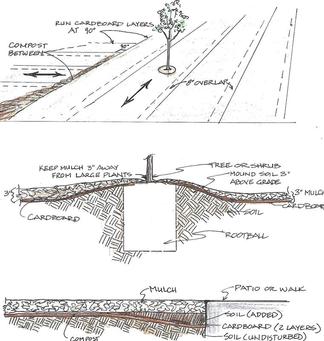Thanks to all who attended the Bringing Back The Natives tour and visited Lauren Kindorf's peaceful garden.
Here are the notes from my talk about using natives for curb appeal. Setting up a structure for the yard is key to creating a neat and welcoming front garden. More information later!
So to get started:
Preplanning information
Reality check:
Take black and white photos from several vantage points, including from each window
Scale:
Find a major feature of the front of the house- use this measurement as scale for
Environment:
Where is the sun/shade? What type of soil do you have? Doe's it drain well or hold water?
Style:
What is the style of your house? Is it large with 2 story stucco columns or long and low?
Here are the notes from my talk about using natives for curb appeal. Setting up a structure for the yard is key to creating a neat and welcoming front garden. More information later!
So to get started:
Preplanning information
Reality check:
Take black and white photos from several vantage points, including from each window
Scale:
Find a major feature of the front of the house- use this measurement as scale for
Environment:
Where is the sun/shade? What type of soil do you have? Doe's it drain well or hold water?
Style:
What is the style of your house? Is it large with 2 story stucco columns or long and low?
Tips:
1 Build around a template
Templates/styles:
private garden
rain garden
contemporary
traditional
meadow
dramatic
2 Include structure for crisp clean lines
Structures:
3 Bulk up the plants
4 Keep it Simple
5 Select tidy plants
6 Contrast those leaves
7 Healthy plants are beautiful plants
1 Build around a template
- Organize the garden around a central idea or template
- stick with the original focus - don't get sidetracked by a pretty plant or try to squeeze
- in too many styles
Templates/styles:
private garden
rain garden
contemporary
traditional
meadow
dramatic
2 Include structure for crisp clean lines
- choose one to three structures to make the left brain happy
Structures:
- paths
- sitting area
- walls
- boulders
3 Bulk up the plants
- lay out large groups of dense shrubs
- select 1-3 varieties of heavy shrubs
- group them in masses based on the scale measurements taken earlier
4 Keep it Simple
- leave space for the plants to grow
- plant away from edges
- fill in with annuals while they grow
- limit the variety of plants
- repeat patterns
- limit the flower color palette
- 60% first color, 20% second color, 10% a third color, 10% others
- Ex. 60% purple, 20% blue, 10% hot pink, 10% yellow and orange
5 Select tidy plants
- In general, garden hybrids of natives will be neater and stay in scale with a suburban garden better than straight species
6 Contrast those leaves
- select plants to contrast texture and color of leaves
- gray/green
- large/medium/small
- dense/open and sculptural
- include spiky
- Pick a plant combo and repeat it throughout the length of the yard
7 Healthy plants are beautiful plants
- select plants for the site- sun/shade, soil, heat/cold
- group by water needs
- plant them properly
- water them in carefully
- soil, drainage
- mulch
- water them appropriately
- get to know your plants- check up on them every week
- what do they need?

 RSS Feed
RSS Feed
